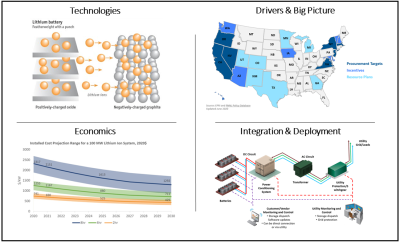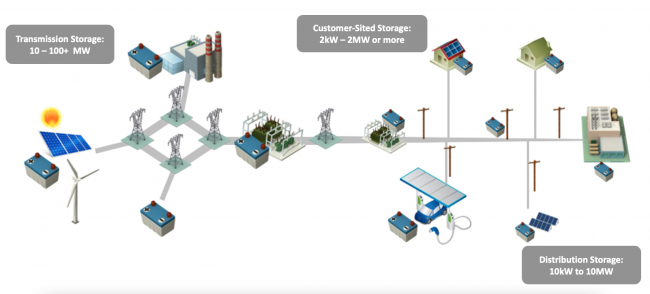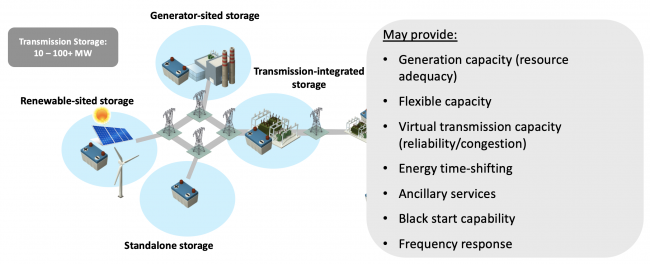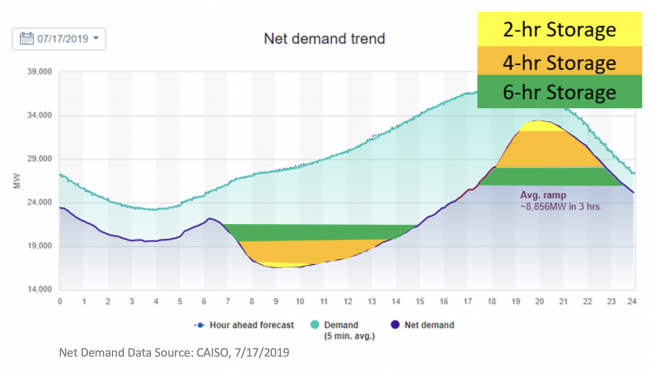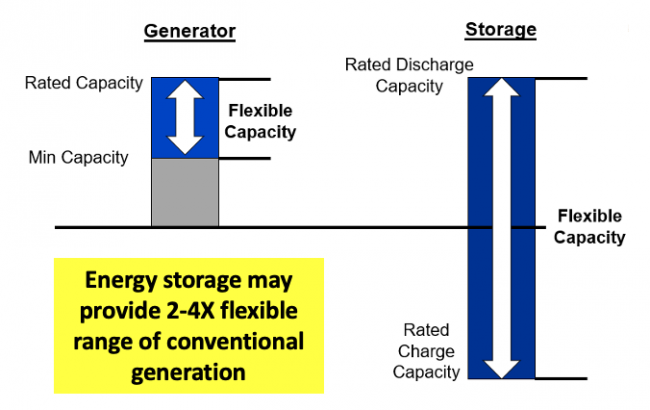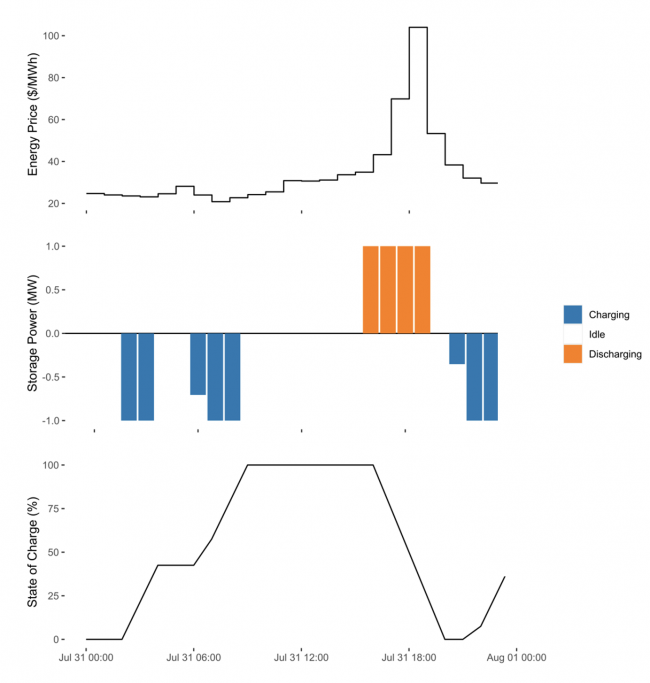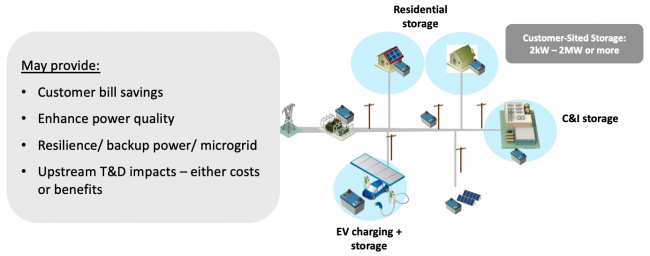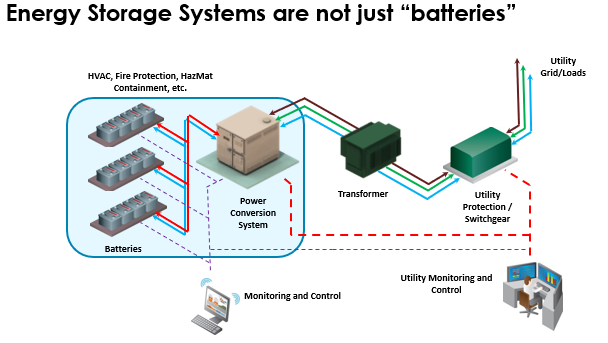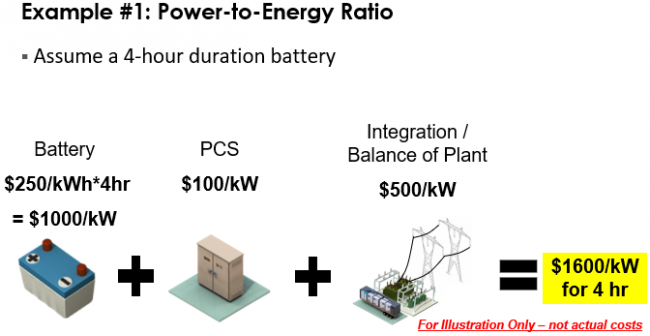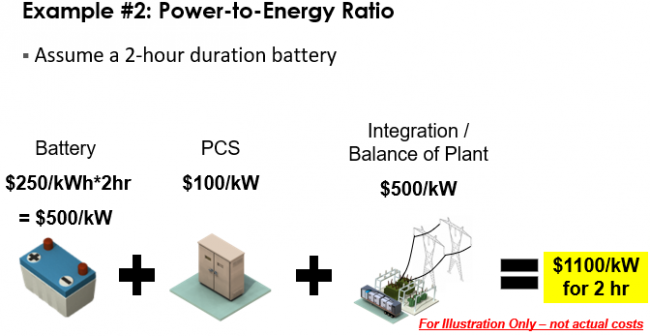Difference between revisions of "Energy Storage 101"
| Line 49: | Line 49: | ||
{{DISPLAYTITLE: Energy Storage {{SUBPAGENAME}}}} | {{DISPLAYTITLE: Energy Storage {{SUBPAGENAME}}}} | ||
==Energy Storage Economics== | |||
===Introduction to Grid Services=== | ===Introduction to Grid Services=== | ||
The economics of energy storage is reliant on the services and markets that exist on the electrical grid which energy storage can participate in. These value streams differ by region, electrical system, and grid domain (i.e. transmission, distribution, customer-sited). | The economics of energy storage is reliant on the services and markets that exist on the electrical grid which energy storage can participate in. These value streams differ by region, electrical system, and grid domain (i.e. transmission, distribution, customer-sited). | ||
Revision as of 11:00, 14 May 2024
This content is intended to provide an introductory overview to the industry drivers of energy storage, energy storage technologies, economics, and integration and deployment considerations. ES 101 may be helpful for bringing new stakeholders up to speed on the energy storage landscape.
The content is based on EPRI's Energy Storage 101 training courses. We will continue to build out the content with up-to-date content. If you have any suggestions, please email Erin Minear.
Drivers for Energy Storage
There are various factors and forces that are currently driving the adoption of energy storage and influencing the current energy storage landscape throughout the world. Since 2018, the size and duration of projects has generally increased. Announcements for new battery energy storage sites planned over the next 2-3 years have grown — now, individual sites may host hundreds of megawatts and nearly a gigawatt-hour each. By the end of 2018, battery energy storage had been deployed in nearly every region of the U.S. under a variety of ownership models. IPPs owned most of the power capacity, providing market services for ISOs like PJM and ERCOT. Conversely, IOUs owned most of the energy capacity, serving needs such as renewable firming and load shifting in places like California and New England. [1]
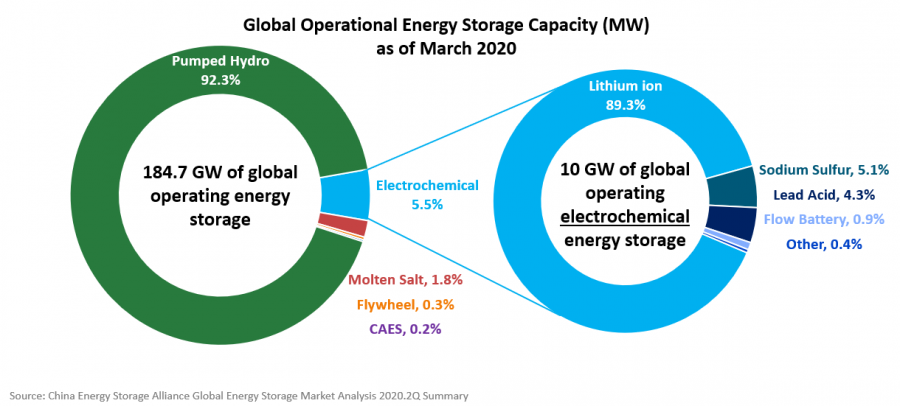
Decreases in Technology Costs
Massive research and development investment and manufacturing scale-up has driven costs down for lithium ion battery storage. This was initially driven by the consumer electronics market (e.g. cell phones and laptops) and more recently accelerated by the electric vehicle market. There has been an almost 90% reduction in $/kWh cost in the last decade and lithium ion costs are expected to continue to decrease with additional manufacturing improvements and economies of scale. Solar and wind technology cost reductions are also driving deployment of energy storage for hybrid applications. Bloomberg New Energy Finance projects 2030 lithium ion pack costs at $62/kWh based on observed prices and an 18% learning rate.[3]
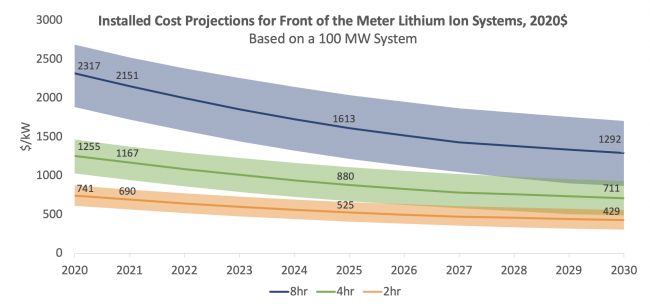
Increasing Renewable Generation
Solar photovoltaic (PV) is driving midday over generation and increased evening ramping requirements which provides a value stream for flexible energy storage. As more solar comes online, the effective net load in the middle of the day decreases. Similarly, wind energy is also driving flexibility needs.
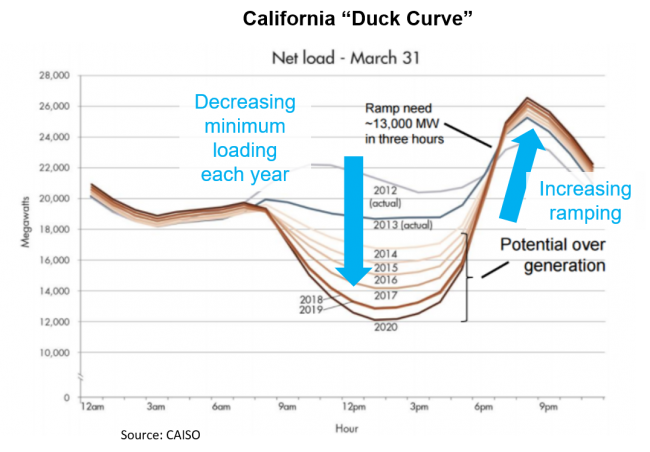
Evolving Utility Needs
- The grid infrastructure (generation, transmission, and distribution) is sized for infrequent peak needs and therefore most assets are under-utilized most of the time. Energy storage can support peak load reduction to provide significant cost reduction opportunity to electricity customers.
- Utility asset infrastructure is aging and peak load reduction may extend asset life and offer opportunity to consider investment in new technologies.
- Peaker plants are only used a fraction of hours per year and energy storage is being considered as peaking capacity in generation planning. Battery storage is already being deployed for this application and as costs decrease they may be cost competitive with combustion turbines in the next decade. When accounting for operational benefits, the crossover point on cost may be sooner.
Increasing Utility Customer Choice and Engagement
Customers (residential, commercial, industrial) are considering energy storage for:
- Bill savings
- Increased energy independence
- Renewable energy goals
- Backup premise or critical loads
Policy and Regulatory Changes
U.S. Federal Policy
In the last decade there has been a shift in policy towards energy storage. At the federal level, FERC has issued several orders as outline below to support energy storage in markets.
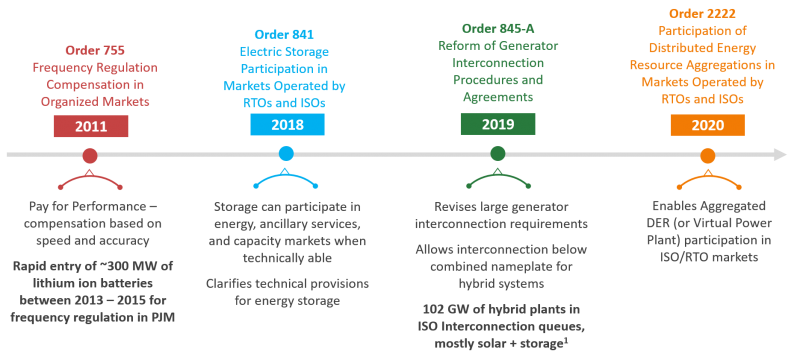
1Lawrence Berkeley National Lab, Hybrid Power Plants: Status of Installed and Proposed Projects.[6]
U.S. State Policy
At the state level, there has been an expanding number of policies to address energy storage in various ways.
- Clean Energy Goals: Carbon-free, renewable portfolio standards, and net-zero goals.
- Procurement Targets: Regulators or legislators set procurement goals and mandates requiring utilities to directly procure or contract storage.
- Resource Plans: State agencies or regulators fund studies or direct utilities to create an energy plan with consideration of storage. Many utilities and states included storage in their resource plan even if not directed to by regulators (not shown on the figure).
- Incentives: Legislators created economic incentives (e.g., rebates or subsidies) for deploying storage.
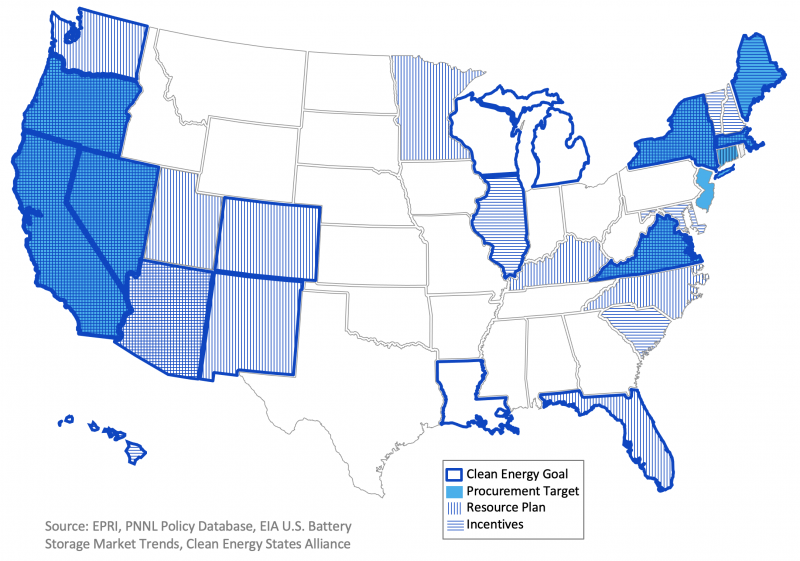
Energy Storage Economics
Introduction to Grid Services
The economics of energy storage is reliant on the services and markets that exist on the electrical grid which energy storage can participate in. These value streams differ by region, electrical system, and grid domain (i.e. transmission, distribution, customer-sited).
Regardless of the situation, at a high level, energy storage can be utilized across the grid in the following ways:
- Capacity Resource: On the electric grid, capacity is synonymous with power, and to be a capacity resource is to provide power that is reliable and firm, so that it can be dispatched when needed. For example, energy storage can charge itself during times when there's excess capacity and essentially become a capacity resource for times when load is peaking in a particular location or region.
- Flexibility Resource: Energy storage has the ability to increase (charge), or decrease (discharge), the total load on the grid at different times very quickly. This characteristic can be leveraged to decrease ramp rate requirements and stresses on traditional assets during times when high generation ramp rates are required. For example, in the early afternoon when grid load demand is low and renewable generation is peaking, traditional generators must quickly ramp down to prevent over-generation on the system. During this time, energy storage can charge itself with excess renewable energy and discharge the energy later in the afternoon, as renewables ramp down and load demand increases.
- Backup Resource: Energy storage can act as a reservoir for energy which can be saved and used when it is needed. If electric power service is disrupted and energy storage is connected to a critical load, the load can use the energy reserve to ride out the disruption.
- Power Quality Resource: Energy storage can be used to affect the voltage or the VARs at a particular point on the grid. This can be accomplished by energy storage systems that have inverters that are capable of "4 quadrant" operation. This functionality enables the inverter and storage system to either produce or absorb VARs which can affect the voltage voltage around the point of interconnection.
Transmission-Connected and Bulk Energy Storage
The figure below provides a list of the services that energy storage can provide at the transmission or bulk energy storage level (generally 10MW or more). These include generation capacity (sometimes called resource adequacy), flexible capacity (sometimes called flexible resource adequacy), virtual transmission capacity (support transmission reliability or alleviate congestion), energy time shift, ancillary services, black start, and frequency response. This section provides more detail.
Generation Capacity (Resource Adequacy)
Generation capacity is the capability and availability of a resource to contribute to system load needs. Capacity resources are typically committed months to years in advance. As demand and resource mixes change, including generator retirements, new resources are needed to ensure capacity needs are met during all hours and conditions. Assuming sufficient storage duration and reliable response times, energy storage may provide reliable load peak reduction. However, energy storage is more challenging to model and assess than traditional generation, because of its limited energy capacity.
Flexible capacity
As more renewables are deployed, daily fluctuations (i.e. ramp rate requirements) in traditional energy generation are increasing. Grid planners must consider these ramp rates in long-term generation resource planning. Energy storage can alleviate ramp rate requirements by absorbing or releasing energy to effectively reduce the maximum ramp rate required by generators.
Virtual transmission capacity (reliability/congestion)
Circuit load growth downstream of transmission assets drives the need for transmission upgrade investments to ensure reliability in both normal and contingency situations. If appropriately sized and placed on the transmission system, energy storage can reliably reduce peak load below capacity threshold by charging during low load times and discharging to serve loads when the threat of transmission system overload arises. With this strategy, utilities may delay traditional transmission upgrade investments for several years resulting in time-value of money savings and rate-payer benefits.
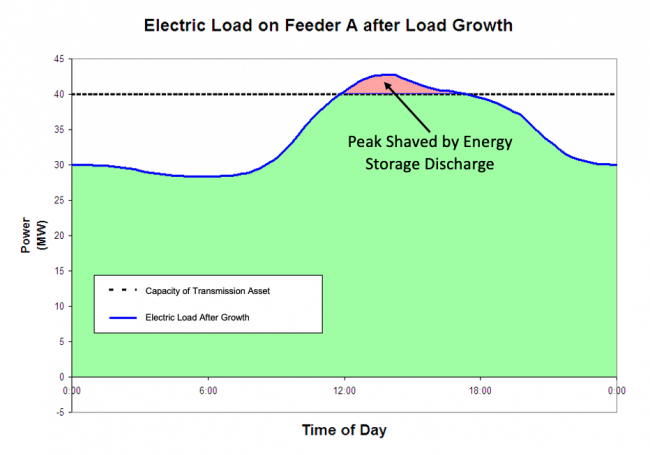
Energy time-shifting
Energy time-shift recognizes an opportunity to economically move energy demand through time taking advantage of fluctuations in the marginal cost of electricity production. To do this, storage can charge when the price of electricity is low (or even negative) and discharge when prices are high. The value of energy time-shift depends heavily on market structure, load growth, and generation mix.
Ancillary services
Ancillary Services are reserve services necessary to support the transmission of electric power from seller to purchaser, given reliability obligations within control areas. The electricity grid operates as a just-in-time delivery system and system operators are responsible for managing voltage, frequency, and system restoration. Variable generation sources such as wind and solar tend to increase uncertainty and variability on the grid. Energy storage, as a flexible resource, can provide instantaneous reserves to balance the grid and leverage it's fast-acting power electronics to perform services like Volt/VAR regulation.
Common ancillary services include:
- Frequency Regulation
- Spinning Reserve
- Non-Spinning Reserve
- Frequency Response
- Black Start
- Voltage/VAR Regulation
Distribution-Connected Energy Storage
The figure below provides a list of the services that energy storage can provide at the distribution level (generally in the 10kW-10MW range). These include virtual distribution capacity, power quality support, resilience / backup power for microgrids, as well as the possibility to provide transmission support in certain scenarios.
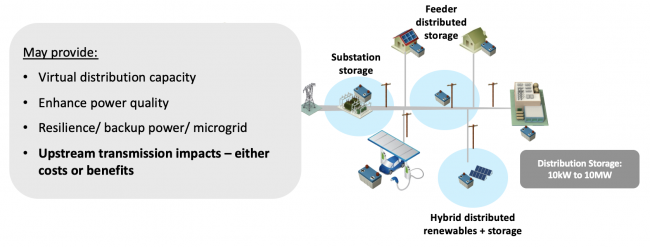
Virtual distribution capacity
This service is similar to the "Virtual transmission capacity", just at the distribution level. In the example depicted below, some time in the near future, more load (homes) will exist on the distribution feeder than the feeder's transformer can handle during peak times. Distribution planners can either upgrade that transformer now, or install an energy storage system downstream of the transformer to ensure its limit is not exceeded for a few more years. In some cases, this energy storage purchase and traditional asset upgrade deferral can provide favorable economics. It is also possible for distribution-connected energy storage systems to provide similar virtual services to the upstream transmission network.
Customer-Sited Energy Storage
The figure below provides a list of the services that energy storage can provide at the customer-sited level (generally in the 2kW-2MW range). These include customer bill savings, power quality enhancements, resilience / backup power for microgrids, as well as the possibility to provide transmission and/or distribution support in certain scenarios.
Value Stacking
Each grid service performed by a battery may provide some economic value, or benefit, but one service alone may not provide enough value to overcome the lifetime costs of the installation. If a specific scenario allows it, it may be possible to approach multiple grid services with one project to improve a projects economics. Keep in mind, there may be regulatory or technical complications that prevent the a project from attempting multiple stacked services.
Understanding Service Compatibility
When value stacking, energy storage service compatibility only flows from bottom up; customer storage may provide distribution and transmission-level services, but transmission storage can NOT provide distribution or customer services.
Reliability vs. Economic Services Reliability services take priority over economic services. For example transmission / distribution deferral services are higher priority than market services.
Local vs. System Level In general, local objectives supersede system objectives when there is a conflict. For example, transmission / distribution deferral is a higher priority than resource adequacy, though operations should be designed such that reliability services never conflict.
Cost Components and Trends
An economic analysis of energy storage systems should clearly articulate what major components are included in the scope of cost. The schematic below shows the major components of an energy storage system. System components consist of batteries, power conversion system, transformer, switchgear, and monitoring and control. A proper economic analysis identifies the costs associated with each of these components.
In addition to identification of major components, there are key BESS services that occur throughout the system's lifetime that need to be accounted for in an economic analysis. The left side of the graphic below shows the beginning of life stacked costs for battery energy storage systems. As shown in the owner's upfront costs, the largest upfront cost is the battery itself. One important consideration, given the significant battery costs, is the sizing assumptions that are used for cost estimates. Often, only a fraction of the procured energy is actually delivered to the customer and some fraction is reserved for safety and performance margins, degradation overbuild, AC/DC losses, or is electrochemically inaccessible. Additionally, the graphic shows relative costs for services throughout BESS operation. These services include operating expenses, fixed system maintenance, and decommissioning and end of life services.
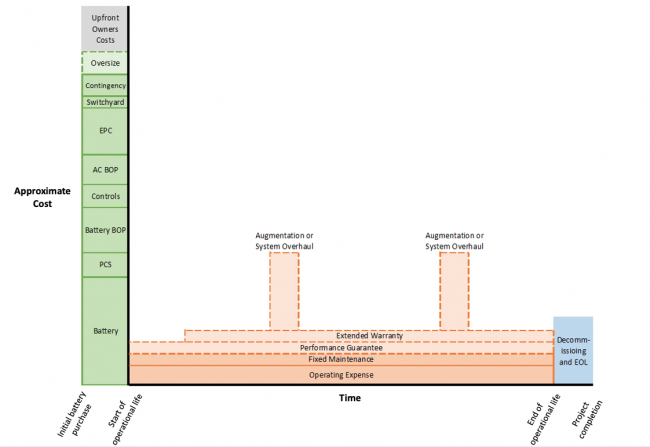
Other generation resource costs are often communicated on a $/kW basis, but energy storage has both power and energy components and the normalized cost will vary with duration. This is highlighted in two examples below where it's clear that the longer duration system has a higher cost per kW of power.
The image below shows lithium ion cost projections from a 2020 EPRI cost study. As demonstrated in the two examples above, the longer duration systems, as of 2020, are more expensive per kW than the shorter duration systems. However, EPRI's cost study projects that the cost per kW of 8 hour duration lithium ion systems is decreasing at a faster rate than 2 hour lithium ion systems.
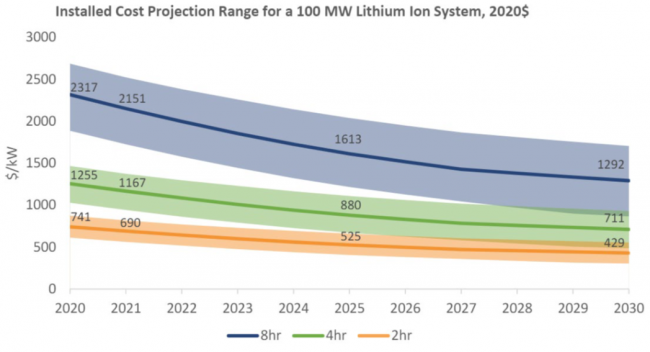
Modeling Energy Storage
Advanced energy storage is a difficult technology to model owing to its limited energy capacity. Operating an energy storage system now can limit its ability to operate in the future. Additionally, energy storage is not yet a common grid asset and is subject to rapidly changing rules, regulations, and standards. But, the flexibility of energy storage can provide a lot of value when operated well and with consideration for the degradation of the system owing to their ability to go from charging to discharging and vice versa quickly and without interruption. Typically, energy storage systems do not serve just one application and instead leverage their flexibility across several stacked services. Service stacking presents additional modeling challenges, though, because the requirements imposed by each service need to be meet in parallel. The need to ensure a storage system can provide stacked services without running out of stored energy typically necessitates detailed, site-specific time series modeling.
Other Resources
EPRI Tools to Support Valuation Modeling
Reports
| Resource | Access Level |
|---|---|
| EPRI Solar Plus Storage Cost Assessment and Design Considerations: Executive Summary (2019) | Publicly Available |
| EPRI Energy Storage Technology and Cost Assessment: Executive Summary (2018) | Publicly Available |
| ESIC Energy Storage Cost Tool and Template | Publicly Available |
| Energy Storage Valuation in California: Policy Planning and Market Information Relevant to the StorageVET Model | Publicly Available |
Energy Storage Technologies
- Definition of energy storage
- Characteristics of energy storage: How to understand and consider performance
- Survey of technologies: Different storage mediums
Energy Storage Integration and Deployment
References
- ↑ Helman U, Kaun B, and Stekli J (2020) "Development of Long-Duration Energy Storage Projects in Electric Power Systems in the United States: A Survey of Factors Which Are Shaping the Market"
- ↑ China Energy Storage Alliance (CNESA): "Global Energy Storage Market Analysis—2020.Q2 (Summary)"
- ↑ BloombergNEF: "A Behind the Scenes Take on Lithium-ion Battery Prices"
- ↑ "EPRI Battery Energy Storage Lifecyle Cost Assessment Summary: 2020"
- ↑ California Independent System Operator (CAISO): "What the duck curve tells us about managing a green grid"
- ↑ Lawrence Berkeley National Lab, Hybrid Power Plants: Status of Installed and Proposed Projects
- ↑ Pacific Northwest National Laboratory (PNNL): Energy Storage Policy Database
- ↑ EPRI: "Battery Energy Storage Lifecycle Cost Assessment Summary 2020"
- ↑ EPRI: "Battery Energy Storage Lifecycle Cost Assessment Summary 2020"
Additional Resources
